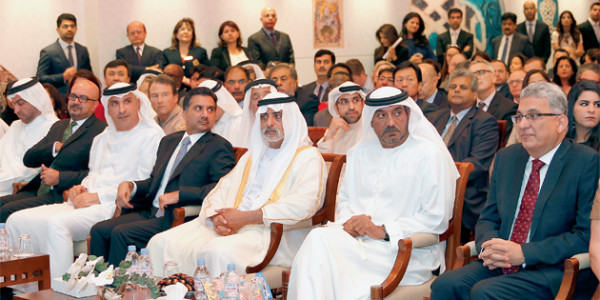Taylor Scott International News
Dubai opens window to priceless Islamic legacy Staff Reporter / 19 March 2014 Offers preview of Aga Khan Museum, the first Islamic art showcase in N. America. Michelangelo. Leonardo da Vinci. Velazquez. Cezanne. Van Gogh. Sir Joshua Reynolds. Jackson Pollock. Name the artists famed worldwide and you won’t find a single Islamic artist among them, that is, not one known to the man on the street. “Most people can’t name a single Muslim artist. I find this terrible,” says Henry Kim, curator and historian. Shaikh Nahyan (3rd from R) at the preview of the Aga Khan Museum at the Ismaili centre in Dubai. He is flanked by Shaikh Ahmed bin Saeed Al Maktoum, President of Civil Aviation Authority and Chairman of The Emirates Group, Arif Lalani, Ambassador of Canada to the UAE, and other officials — KT Photos by Juidin Bernarrd Though Islamic art has been flourishing for over 1,400 years spread over a vast canvas stretching through Europe, Africa, the Middle East and Asia, its amazing beauty and diversity is yet to gain the recognition it deserves. But come autumn and the lacuna will be addressed as the Aga Khan Museum, the first museum in North America devoted solely to Islamic art, opens in Toronto. The sprawling museum, designed by Japanese Fumihiko Maki, will display over 1,000 artefacts from the personal collection of the Aga Khan and his family. “It will be a proud destination for Muslim and non-Muslim visitors, showcasing the art, science, music and philosophy of Islamic culture,” adds Arif Lalani, Canadian ambassador to the UAE and Canada’s Special Envoy to the Organisation of Islamic Cooperation. A tour of the Aga Khan Museum The Aga Khan Museum, says Henry Kim, its director and CEO, would promote art and culture of the Muslim world and build bridges between cultures. Besides the museum, the three-pronged project also has a park designed by Vladimir Djurovic and an Ismaili Centre planned by Charles Correa. Nearly 1,700sq m space has been kept aside for both permanent and temporary exhibitions. The objects on display are as various as the Holy Quran in different scripts, illustrations of classics like Firdausi’s Shah-Nameh (The Book of Kings), carpets, jade ware and exquisite ceramic art that shows the influence of China. Muslim explorers and navigators left an indelible mark on history. The museum pays a tribute to them, especially through its display of astrolabes, the navigating tool used by sailors of all religions to find their way by calculating planetary positions. The preview has an exquisite bronze astrolabe made in the 18th century by Qazi Ali of Iran. A special place will be given to the section of art pieces called In search of artists. The art here is all signed by the artists and Kim hopes it will help familiarise the audience with Muslim artists as well. There will also be a Garden of Ideas section, focusing on different countries. Since the Aga Khan Museum plans to bring the sights, rhythms and sounds of Islamic culture as well, Japanese architect Fumihiko Maki has created a state-of-the-art elegant auditorium that can seat 350 people and will host regular performances. sudeshna@khaleejtimes.com With Dubai being a cultural hub, the museum chose the emirate to offer a preview on Tuesday. “I wish that we were gathering today to open the Aga Khan Museum in the United Arab Emirates,” said a wistful Shaikh Nahyan bin Mubarak Al Nahyan, the UAE’s Minister of Culture, Youth and Community Development, in his keynote address at the event. Islamic art, with its astonishing plurality, is an important part of the heritage of mankind. “The museum preserves important artefacts of our Islamic heritage,” Shaikh Nahyan said. “They communicate our history, culture, and art. Those artefacts convey a clear sense of Muslim diversity, a diversity that deserves global prominence.” “Culture and art are important for peace, understanding and harmony in the world,” Shaikh Nahyan added. A deeper appreciation of art and culture leads to goodwill and friendship, building bridges between diverse religions, cultures and backgrounds for a peaceful and prosperous world. Shaikh Nahyan also referred to the 88th Ogden memorial lecture delivered last month by the Aga Khan at the US Ivy League Brown University to emphasise why the world needs to retain its diversity: When people stop learning and understanding each other’s cultures, it leads to misunderstanding and hostility. Today’s world, being inter-connected, requires a thoughtful, renewed commitment to pluralism. “We understand the wisdom of that response,” Shaikh Nahyan said. “We are a cosmopolitan society bound by mutual respect and understanding… Art allows us to celebrate the principles and values that unite us across national and cultural boundaries and highlights our common values and pursuits.” He also quoted the UAE President, His Highness Shaikh Khalifa bin Zayed Al Nahayan: “The United Arab Emirates has relied, and will continue to rely, on the rich and diverse contributions of its true wealth, its people, to guarantee its prosperity.” Several factors contributed to make Dubai ideal for the preview. The host of the event, the Ismaili Centre Dubai, has been organising a series of cultural programmes since its inception in 2008 to share knowledge with other communities. Also, the preview comes during Art Dubai, the annual event drawing VIPs and art connoisseurs to select sites where art displays are held. Finally, as the Canadian ambassador said, Canada admires the UAE’s diversity and the Dubai preview would introduce the Aga Khan Museum to the Middle East. While Toronto would have the Islamic art museum, Abu Dhabi would have the Louvre Abu Dhabi and both countries would be home to world-class museums. sudeshna@khaleejtimes.com For more news from Khaleej Times, follow us on Facebook at facebook.com/khaleejtimes , and on Twitter at @khaleejtimes Taylor Scott International
Taylor Scott International, Taylor Scott








